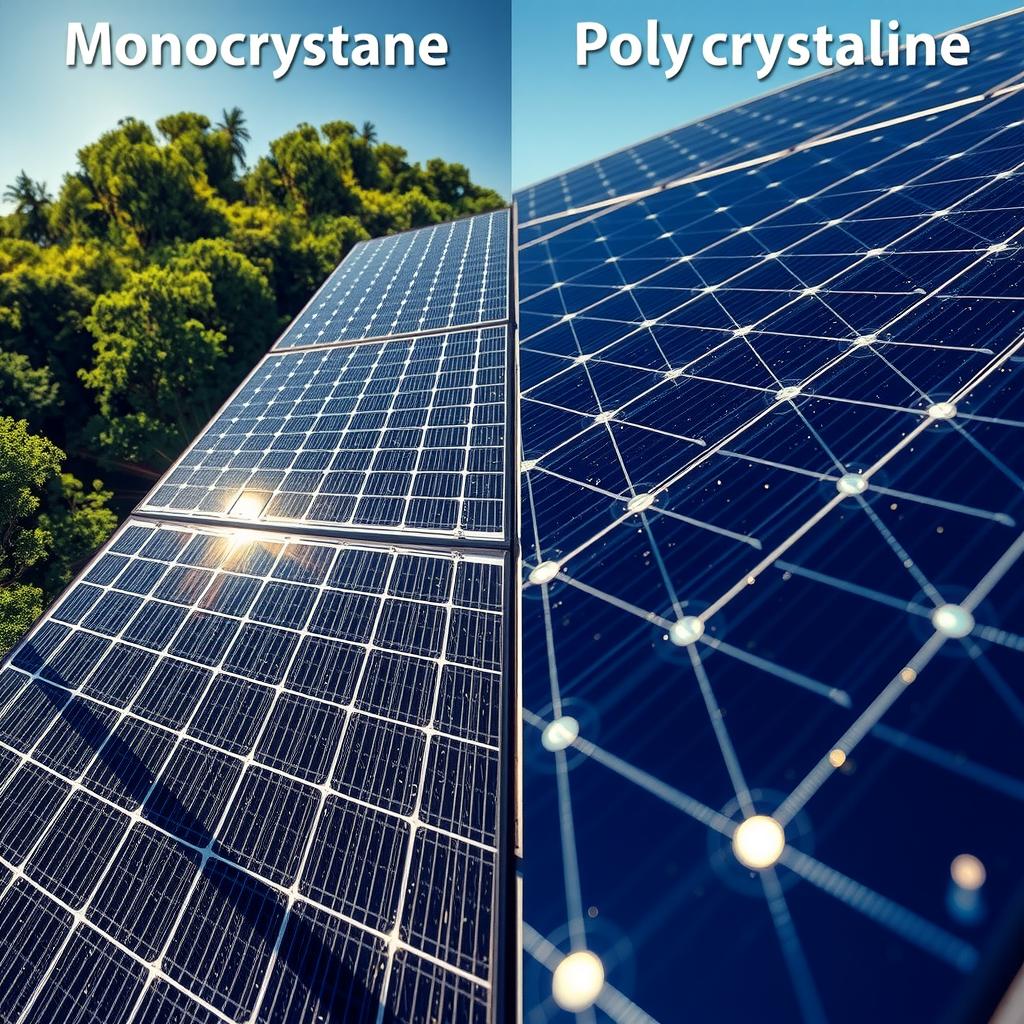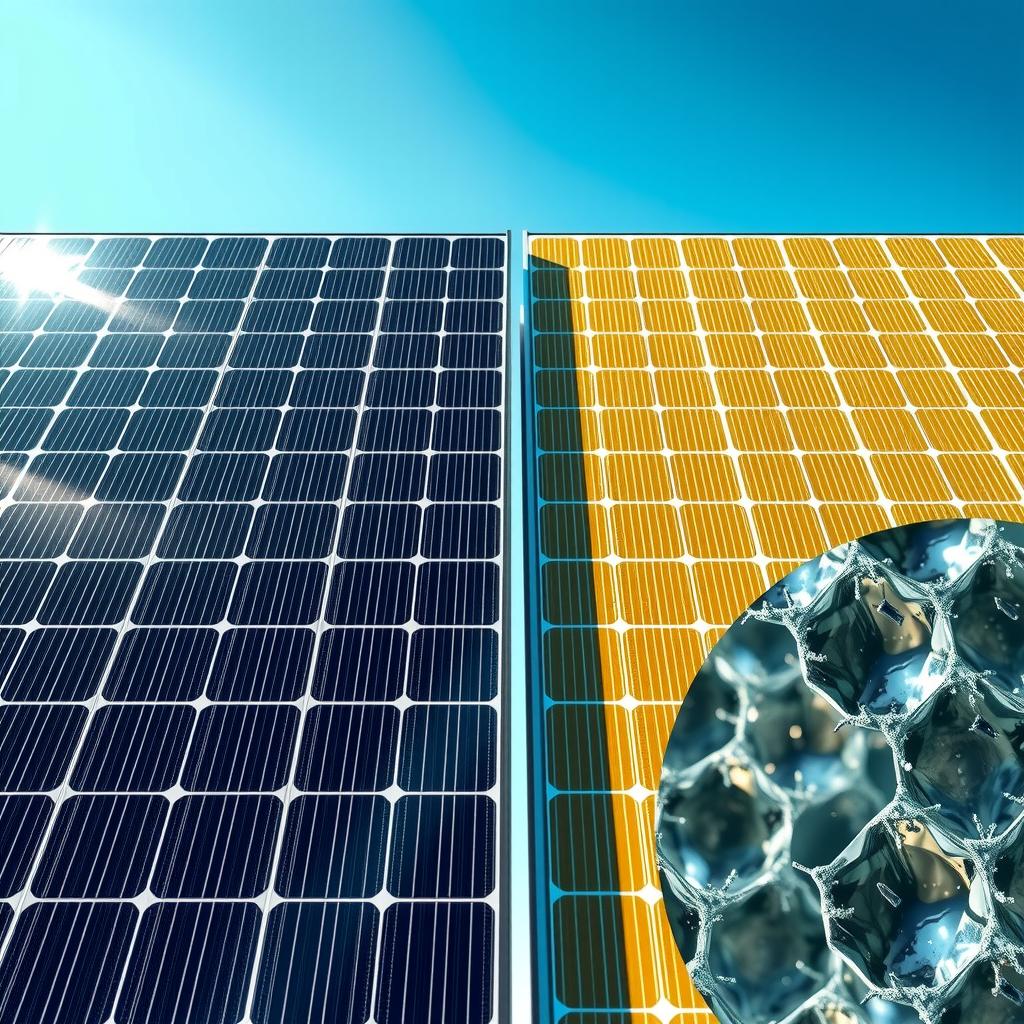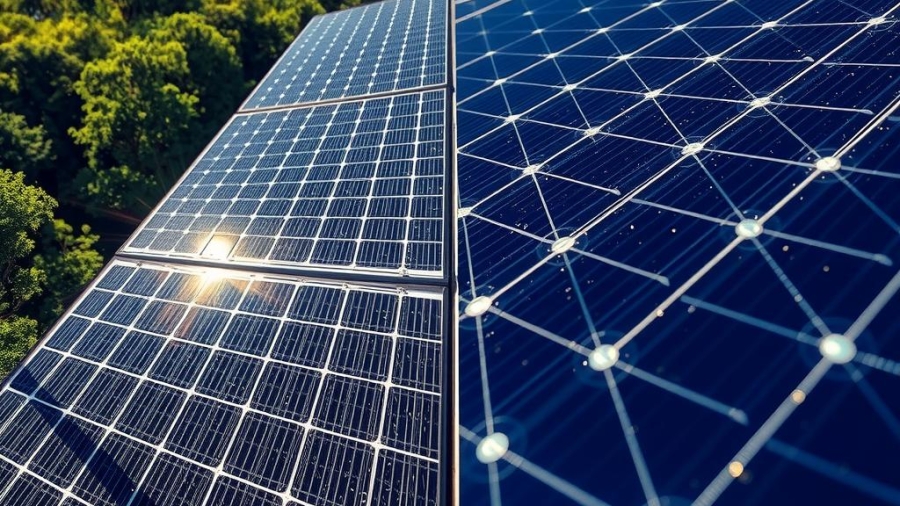As the world increasingly turns to renewable energy sources, solar panels have emerged as a popular solution for harnessing the sun’s power. However, with numerous options available in the market, potential buyers often find themselves at a crossroads: Should they invest in a monocrystalline solar panel or opt for a polycrystalline solar panel? This question is crucial not only for maximizing energy efficiency but also for ensuring that one’s investment aligns with long-term goals in sustainability and cost-effectiveness. The decision between these two types of photovoltaic technology can significantly impact both performance and financial return on investment.
Understanding the fundamental differences between monocrystalline solar panels and polycrystalline solar panels is essential for anyone looking to integrate solar energy into their home or business. While both technologies convert sunlight into electricity, they do so through different processes and materials, leading to variations in efficiency, appearance, space requirements, and overall costs. For instance, monocrystalline panels, known for their sleek black look and higher efficiency rates—often exceeding 20%—are typically more effective when it comes to producing electricity from limited roof space. On the other hand, polycrystalline panels, characterized by their blue speckled surface and slightly lower efficiencies (ranging around 15-17%), tend to be less expensive upfront but may require more area to achieve similar output levels.
This comparison becomes even more pressing when considering installation tips that can affect system performance based on geographic location or specific residential needs. With each type offering distinct advantages depending on individual circumstances such as budget constraints or aesthetic preferences, understanding these nuances empowers readers to make informed decisions about which type of solar panel best suits their unique situation.
In this blog post titled “Monocrystalline vs Polycrystalline Solar Panel Comparison,” we will delve deeper into each technology’s characteristics while providing insights into cost analysis and practical applications. By addressing common concerns related to performance versus price point along with expert advice tailored toward optimizing each choice’s benefits within real-world scenarios—readers will gain clarity on how best to proceed towards embracing sustainable living through effective use of renewable energy solutions like solar power systems.

Key Points:
- Energy Efficiency Comparison: Understanding the performance metrics of monocrystalline solar panels and polycrystalline solar panels in various conditions.
- Cost Analysis Insights: Evaluating the financial implications and budget considerations associated with both types of solar technology.
- Installation Tips for Homeowners: Practical advice on installation requirements that impact project timelines and overall efficiency.
When evaluating renewable energy options, homeowners should prioritize understanding the differences in energy efficiency between monocrystalline solar panels and polycrystalline solar panels. Generally speaking, monocrystalline variants are distinguished by their higher purity silicon, which translates into superior performance under a range of environmental conditions. This means they tend to generate more electricity per square foot compared to their polycrystalline counterparts. Therefore, individuals with limited roof space may find that investing in a monocrystalline solution offers greater benefits due to its efficient design.
In terms of cost analysis, potential buyers need to weigh the initial investment against long-term savings when choosing between these two types of photovoltaic technology. While monocrystalline solar panels often come at a premium price point due to their manufacturing process and efficiency rates, many homeowners recognize that this upfront cost can be offset by lower electricity bills over time. On the other hand, those who opt for more economical choices like polycrystalline solar panels, despite slightly lower performance levels, can still achieve significant energy cost reductions without breaking the bank.
Lastly, installation tips play an essential role in determining which type of system will best suit one’s needs. The installation requirements may vary significantly based on whether homeowners choose monocrystalline or polycrystalline. For instance, while both systems typically require similar mounting structures and wiring setups, considerations about shading effects—more prevalent with polycrystalline installations—can influence overall efficacy post-installation. Thus understanding these nuances not only aids consumers during decision-making but also enhances their experience throughout any renewable energy initiative.
By focusing on these areas—energy efficiency comparisons among different panel types; conducting thorough cost analyses; gathering relevant installation tips—homeowners can navigate through their options with confidence as they transition towards sustainable living solutions powered by solar energy.

A Comparative Insight into Solar Panel Technologies
Exploring the Distinct Characteristics of Monocrystalline and Polycrystalline Panels
The realm of solar energy has witnessed remarkable advancements, particularly with two prominent technologies: monocrystalline solar panels and polycrystalline solar panels. Understanding these alternatives is crucial for homeowners and businesses contemplating the installation of photovoltaic systems. At their core, monocrystalline solar panels are crafted from a single crystal structure, which allows them to achieve higher efficiencies—typically ranging between 15% to 22%. This high efficiency stems from their uniform composition that allows electrons to flow more freely compared to their polycrystalline counterparts. In contrast, polycrystalline solar panels, composed of multiple silicon crystals melded together during production, generally exhibit lower efficiency levels between 13% to 16%. However, this does not render them less effective; rather it reflects differences in manufacturing processes that ultimately influence performance under various conditions.
In addition to efficiency metrics, cost analysis plays a significant role in distinguishing these two types of solar technology. The manufacturing process for monocrystalline solar panels is typically more complex and resource-intensive due to the need for pure silicon material; hence they often come at a premium price point. Conversely, polycrystalline solar panels tend to be less expensive because their production process requires fewer resources and can yield larger quantities simultaneously. For budget-conscious consumers seeking renewable energy solutions without sacrificing too much on overall output capacity or longevity—often exceeding 25 years for both panel types—the choice may lean towards polycrystalline options despite their marginally lower efficiency ratings. It’s imperative for potential buyers to consider not only initial costs but also long-term investment benefits including maintenance expenses and available warranties when conducting a thorough comparison.
Making an Informed Decision
Factors Influencing the Choice Between Monocrystalline and Polycrystalline Panels
When evaluating options within photovoltaic technology such as choosing between monocrystalline solar panels or polycrystalline solar panels, several other factors come into play beyond mere efficiency ratings or price points. For instance, installation tips suggest that the space available can significantly affect what type one should opt for; given their heightened effectiveness per square foot due primarily through superior design attributes like sleekness in appearance combined with compact size capabilities—those who have limited roof areas might find themselves favoring monocrystaline models as they maximize sunlight capture better than poly crystalline variants would allow in constrained environments.
Moreover, geographical location impacts performance characteristics considerably as well; areas receiving ample direct sunlight can benefit from either type but will likely see greater returns on investment with monocrystals over time due specifically related increases in power generation rates under optimal conditions while poly crystalline setups remain advantageous where budget constraints exist alongside moderate sunshine levels experienced regularly throughout seasons across varied terrain settings.
Ultimately making informed decisions about utilizing renewable energy sources demands comprehensive understanding encompassing all dimensions inherent surrounding each option within this burgeoning market segment focused on sustainability efforts globally aimed at reducing carbon footprints efficiently through strategic selections informed by personal needs aligned closely toward achieving desired outcomes effectively leveraging distinctive features presented by either variant thus ensuring maximum utility derived directly attributed back towards fulfilling broader environmental goals collectively shared amongst individual users alike sustainably moving forward collectively contributing positively toward global clean energy initiatives comprehensively addressing pressing climate challenges faced today resolutely enhancing future prospects enduringly.
Understanding Solar Panel Performance in Diverse Climates
Analyzing the Efficiency of Different Solar Technologies
The efficiency of solar panels varies significantly based on environmental conditions, making it essential to understand how each type performs under different scenarios. The monocrystalline solar panel, known for its high efficiency and sleek design, tends to perform exceptionally well in sunny climates. Its ability to convert sunlight into electricity is top-notch, often achieving efficiencies above 20%. This advantage means that homeowners in areas with abundant sunshine can generate more energy from a smaller surface area compared to other types. However, when temperatures rise excessively, the performance of monocrystalline panels may slightly decline due to thermal inefficiencies. Conversely, the polycrystalline solar panel, which is generally less efficient at around 15-17%, offers an economic alternative with lower production costs but can be more susceptible to severe weather conditions like snow or heavy rain. It’s crucial for potential users to weigh these factors against their specific climate conditions when considering installation.
The Impact of Temperature on Energy Production
How Heat Affects Solar Panel Efficiency
Temperature plays a critical role in determining the energy output from both monocrystalline solar panels and polycrystalline solar panels. As temperature increases, particularly beyond optimal levels (typically around 25°C), both types experience a decrease in efficiency; however, this effect is more pronounced in polycrystalline variants due to their lower heat tolerance threshold. Studies indicate that for every degree Celsius increase above this optimal temperature range, there could be a drop ranging from 0.3% up to over 0.5% depending on the technology used and quality of materials involved—leading many consumers toward investing in higher-quality monocrystalline options where available and feasible within their budgets. In cooler regions or during winter months, both technologies thrive as colder air improves conductivity; thus leading towards better performances overall regardless of type chosen.
Performance Under Shading Conditions
Evaluating Output During Partial Blockage
Shading poses another significant challenge that influences energy production across different environments for all types of photovoltaic technology including monocrystalline solar panels and polycrystalline solar panels alike—but they respond differently under such constraints! Monocrystals tend not only outshine polys when exposed even partially shaded since they have individual cells wired together allowing them greater flexibility while maintaining higher outputs despite blockages caused by trees or neighboring structures obstructing direct light paths onto installed surfaces—a major consideration especially relevant before installation efforts begin! Thus understanding local geography becomes imperative: if residences are likely compromised by elements casting shadows throughout days then opting for monolithic solutions may lead toward maximizing available resources efficiently!
Long-Term Savings Through Energy Generation
Calculating Cost-Benefit Over Time
In assessing long-term savings potential associated with renewable energy investments such as those made through either type mentioned previously—the ultimate goal remains cost-effectiveness alongside sustainability objectives pursued across generations ahead! While upfront costs will vary widely depending upon geographical location along with individual vendor offerings—often requiring thorough cost analysis prior decision making—it’s important also evaluate expected return rates derived directly through comparative outputs generated between technologies deployed over time frames typically spanning decades (with warranties supporting system reliability extending anywhere between twenty-five years upwards). Those choosing higher-efficiency products like monocrystallines, despite initial price discrepancies might ultimately discover substantial returns realized via minimized utility bills accrued over lifespan versus basic alternatives offered elsewhere yielding lesser gains yet posing risks related replacement cycles sooner than anticipated arising unforeseen failures common among cheaper units deployed initially without thoughtful considerations taken beforehand regarding future landscape evolution changes impacting installations deeply affecting productivity thereafter too!
Cost Analysis and Installation Considerations
Understanding the Financial Implications of Renewable Energy
The decision to invest in renewable energy, particularly solar power, is intricately tied to both cost analysis and installation considerations. With rising electricity prices and growing environmental concerns, many homeowners are turning towards solar panels as a viable solution. When evaluating options like monocrystalline solar panels versus polycrystalline solar panels, it is essential to consider not only the upfront costs but also long-term savings on energy bills. A thorough financial breakdown reveals that while monocrystalline solar panels typically come with a higher initial price tag due to their efficiency levels—yielding more electricity per square meter—they often pay themselves off quicker through reduced utility bills compared to their polycrystalline counterparts.
Installation requirements play a pivotal role in determining the overall investment value for prospective buyers of photovoltaic technology. For instance, the installation of monocrystalline solar panels may require less physical space owing to their superior efficiency; therefore, they can be better suited for homes with limited roof area. Conversely, those opting for polycrystalline solar panels, which tend to have lower efficiency rates per unit area, might need larger installations or additional roof space dedicated solely for energy generation purposes. This consideration significantly impacts both cost estimates and potential returns on investment (ROI).
Moreover, smart installation tips can further optimize these investments in renewable energy systems. Engaging professional installers who understand local regulations not only ensures compliance but also enhances system performance by optimizing panel orientation and tilt angles based on geographic location. Additionally, understanding how seasonal sunlight variations impact each type of panel’s output will enable property owners to make informed decisions aligned with their specific needs—potentially favoring one type over another depending on local climatic conditions.
A comprehensive cost analysis should also include potential incentives such as tax credits or rebates available from governments promoting renewable energy adoption; these factors can substantially reduce net expenses associated with purchasing either type of solar panel system. As individuals evaluate choices between monocrystalline vs polycrystalline solar panels, conducting side-by-side comparisons that incorporate all variables—from purchase price through lifetime maintenance costs—will aid consumers in making an informed choice tailored specifically for their circumstances.
In conclusion, understanding both financial implications alongside detailed installation requirements remains crucial when contemplating transitioning into renewable energy solutions like residential photovoltaic systems powered by either monocrystalline or polycrystalline technologies. By taking time to delve deep into these aspects before committing resources toward implementation efforts will ultimately ensure maximum returns while contributing positively towards sustainable living practices that benefit society at large.
Frequently Asked Questions:
Q: What are the primary differences between monocrystalline solar panels and polycrystalline solar panels in terms of energy efficiency?
A: The main distinction lies in their energy efficiency rates. Monocrystalline solar panels generally offer higher efficiency due to their manufacturing process, which uses pure silicon. These panels typically achieve efficiencies above 20%. In contrast, polycrystalline solar panels, made from multiple silicon crystals, tend to have slightly lower efficiency ratings, usually ranging between 15% to 18%. This means that for homeowners with limited roof space, investing in monocrystalline solar panels might be more beneficial.
Q: Are there significant cost differences when purchasing monocrystalline solar panels versus polycrystalline solar panels?
A: Yes, there is a notable cost difference. While both options provide viable solutions for harnessing solar energy, monocrystalline solar panels are often more expensive due to their higher production costs and better performance metrics. On the other hand, homeowners seeking a budget-friendly option may find that polycrystalline solar panels , although less efficient, represent a more economical alternative without sacrificing too much on overall output.
Q: What installation tips should I consider when choosing between these two types of solar panel technologies?
A: When deciding between installing either type of solar panel, it’s essential to consider factors such as available roof space and local sunlight exposure. If opting for monocrystalline, ensure that your installation area can accommodate fewer but highly efficient units; this can lead to quicker installations and potentially lower labor costs. Conversely, if selecting the more affordable option of polycrystalline, be prepared for needing more units to achieve similar power output levels. Additionally, consulting with professionals familiar with both types can provide tailored advice on optimizing your system’s setup based on specific home conditions and requirements related to photovoltaic technology.
